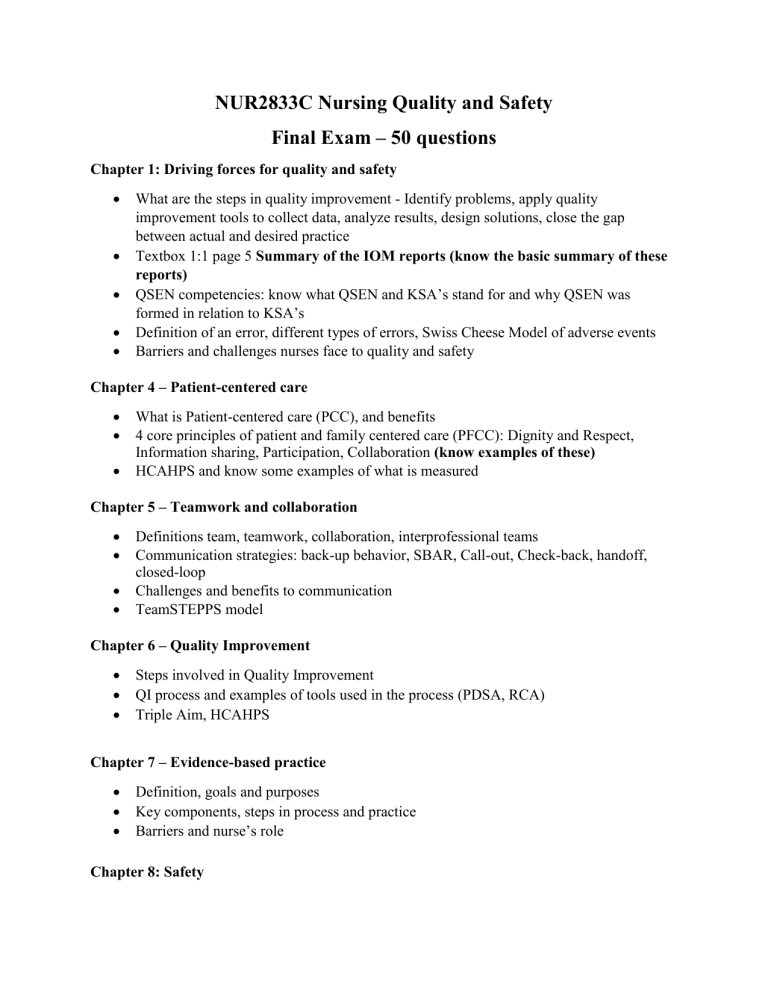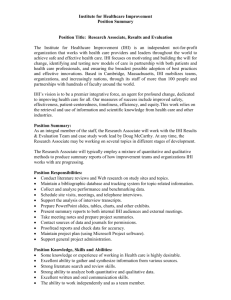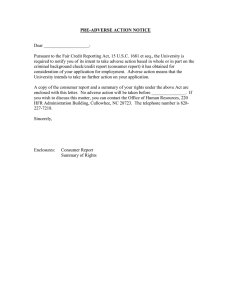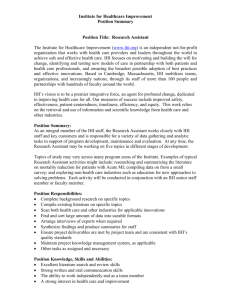
NUR2833C Nursing Quality and Safety Final Exam – 50 questions Chapter 1: Driving forces for quality and safety What are the steps in quality improvement - Identify problems, apply quality improvement tools to collect data, analyze results, design solutions, close the gap between actual and desired practice Textbox 1:1 page 5 Summary of the IOM reports (know the basic summary of these reports) QSEN competencies: know what QSEN and KSA’s stand for and why QSEN was formed in relation to KSA’s Definition of an error, different types of errors, Swiss Cheese Model of adverse events Barriers and challenges nurses face to quality and safety Chapter 4 – Patient-centered care What is Patient-centered care (PCC), and benefits 4 core principles of patient and family centered care (PFCC): Dignity and Respect, Information sharing, Participation, Collaboration (know examples of these) HCAHPS and know some examples of what is measured Chapter 5 – Teamwork and collaboration Definitions team, teamwork, collaboration, interprofessional teams Communication strategies: back-up behavior, SBAR, Call-out, Check-back, handoff, closed-loop Challenges and benefits to communication TeamSTEPPS model Chapter 6 – Quality Improvement Steps involved in Quality Improvement QI process and examples of tools used in the process (PDSA, RCA) Triple Aim, HCAHPS Chapter 7 – Evidence-based practice Definition, goals and purposes Key components, steps in process and practice Barriers and nurse’s role Chapter 8: Safety Definition of an error Categories of errors/failures (latent, active, indirect, technical), know examples of these. Differences between the following errors: lapse, slip and mistake Nine (9) categories that provide opportunities to improve patient safety and examples of these Difference between RCA and FMEA Challenges to patient safety Chapter 14: Interprofessional approaches to quality and safety education IPE – why is this important and what are the six broad themes Core competencies – values/ethics for interprofessional practice, roles/responsibilities, interprofessional communications, teams and team works (know the description of these) Core features that contributes to successful interprofessional learning (Cooperative, reflective, experiential and promotion/transfer learning) - know examples of theses Chapter 16: Leadership to create change Know Medication reconciliation process Collaborative Partner Presentations Review – Powerpoint (lots of questions from here) Definition and examples of Adverse events Sentinel events Adverse events responses 2nd victim phenomenon RCA process FMEA process Tall man Lettering Comprehensive Unit-based Safety Program (CUSP) Hospital Acquired Infections (HAI’s) what are these and examples The Joint Commission and National Patient Safety Goals – purpose Just culture and patient safety IHI (Refer to BB student resources for summary of these) IHI PS 101: Introduction to patient safety Lesson 1: Understanding Adverse events and Patient Safety Importance of studying the field of patient safety Why is health care dangerous and how to make changes Lesson 2: Your role in a culture of safety Blaming and punishing Lesson 3: Your role in building safer, more reliable systems. Call to action – what can you do (4 behaviors to improve patient safety) IHI PS 102: From Error to Harm Lesson 1 Swiss Cheese Model – Latent conditions vs active failures (know what these are and examples) Lesson 2 Understanding Unsafe Acts Difference between error and violation Unsafe acts: error, slip, lapse, mistake (examples of these) What is a Central Line and associated infection? Lesson 3 A closer look at harm - IHI definition of harm IHI PS 103: Human Factors and Safety Lesson 1 Understanding the Science of Human Factors What are internal and external factors that make it more prone to errors What is heuristics? Lesson 2 Design Principles to Reduce Human Errors The 8 effective principles for error-reduction designs (know examples of these) Lesson 3 The Risks and Rewards and Technology IHI PS 104: Teamwork and Communication Lesson 1 Why are teamwork and communication important and the fundamentals of teamwork and communication Lesson 2 Tools and techniques for effective communication (critical language, 2-challenge rule, briefings, debriefing, SBAR, repeating back) know examples of these Lesson 3 Safety during transitions Characteristics of a culture of safety (psychological safety, active leadership, transparency, fairness) IHI PS 105: Responding to Adverse Events Lesson 1 Responding to an adverse event, step-by-step approach (know the 4 steps) Lesson 2 Communication apology and resolution (4 components of an effective apology) How do you apologize after a medical error? Lesson 3 The impact of adverse events on caregivers: The second victim Review Video’s Josie King: What are the factors that contributed to Josie’s death? Annie’s story – how a system’s approach can change safety culture Articles: Nurse gives patient paralytic instead of antacid – medication administration process, rights of medication administration




